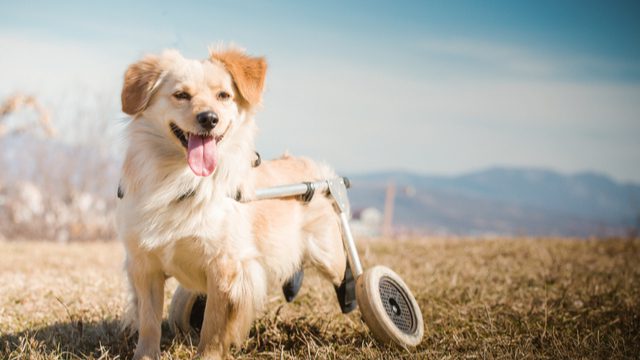Arthritis refers to a degenerative condition that affects older humans, cats, and dogs. Research indicates that older dogs are more likely to suffer from arthritis than younger ones. It is primarily because of a previous injury that may cause joint damage and progressive degeneration of your dogs’ joints. Inflammation may aggravate your four-legged friend’s old wounds and cause pain.
Rheumatoid arthritis refers to an autoimmune disease that affects your dog’s joints. This type of arthritis particularly degrades your dog’s cartilage and can result in permanent lameness. Rheumatoid arthritis is comparatively uncommon in dogs and can cause various symptoms. Here we’ve curated an in-depth guide to what rheumatoid arthritis is, its causes, sign and symptoms, and treatment plans:
Facts about Rheumatoid Arthritis in Dogs
Before we discuss the causes and symptoms of rheumatoid arthritis in dogs, let’s take a look at some facts:
- Rheumatoid arthritis is more common in smaller breeds of dogs
- Rheumatoid arthritis is not as common as other types of arthritis
- Canine rheumatoid arthritis can occur in female as well as male dogs
- Although the age of dogs suffering from rheumatoid arthritis can vary, it typically occurs in those between the age of two to six
What is Arthritis in Pets?
Arthritis refers to inflammation and pain of your pet’s joints. This degenerative disease can affect one, as well as multiple joints.
Arthritis is a super common disease in dogs. In fact, research reveals that 1 in every five dogs experiences arthritis in their lifetime. About 12 million cats across the globe also suffer from degenerative joint conditions.
Veterinarians reveal that arthritis is mainly diagnosed in senior dogs and cats. In addition, it is likely to occur once your pet reaches the age of 10.
Arthritis is a broad term that encompasses any disease where your furry friend has abnormalities in their joints. It may also refer to a condition where the cartilage present between two joints gets damaged. Since the cartilage acts as a cushion, it protects your dog’s joints when they move, walk, or jump.
The degeneration of the cartilage can cause pain, inflammation, and discomfort. It may have a significant impact on its mobility and can, in some cases, cause lameness.
Types of Arthritis
Arthritis can cause inflammation and stiffness in your dog’s joints. It may be of the following two types:
- Osteoarthritis-Otherwise, known as degenerative joint disease, OA is caused by overtime wear and tear. Several factors, including age, genetics, body weight, and activity level, can cause OA in dogs.
- Rheumatoid Arthritis- Rheumatoid arthritis refers to an autoimmune disease that can cause your furry friend’s body to go into hyperdrive. It is comparatively less common than OA.
What Causes Rheumatoid Arthritis in Dogs?

There is no single cause of rheumatoid arthritis in dogs. It could be genetic, side effects of old injuries, or something else. Here we discussed the primary factors that lead to rheumatoid arthritis among dogs:
- Abnormal joint development, i.e., canine hip dysplasia, luxating patellas, and elbow dysplasia
- Activity history
- Body conformation, i.e., how is your dog built
- Body condition and weight aka is your dog obese or overweight
- Injury history including past fractures, muscle injury, ligament damage, erosion of cartilage, damage of cartilage, joint infection
- Nutritional history
- Orthopedic surgery
In most cases, dogs with rheumatoid arthritis experience multiple of these factors. The number of factors may increase as canine arthritis develops and progresses.
In some cases, rheumatoid arthritis may appear as a complication of the following afflictions:
- Cancer
- Canine distemper
- Digestive disease
- Genetic predisposition
- Kidney disease
- Recurrent UTIs
Symptoms of Rheumatoid Arthritis in Dogs
Signs and symptoms of rheumatoid arthritis are difficult to detect in its early stages. However, symptoms may become apparent as pain increases.
Here we discuss the symptoms of rheumatoid arthritis in dogs:
Abnormal Posture
Rheumatoid arthritis can affect different parts of your dog’s spine. As a result, you may notice an abnormal posture, a sore neck, a hunched back, and lameness in the hind leg(s).
Abnormal Grooming
Dogs suffering from rheumatoid arthritis may bite, lick, or chew body areas that hurt. In severe cases, the biting and chewing may cause baldness or inflamed skin.
In some cases, your pet may stop grooming itself due to pain and inflammation during movements.
Limping
If your dog has arthritis, chances are, it’ll start favoring one of its limbs. You may even notice a distinct limp when your dog walks, runs, or jogs. The severity and type of limp depends on the affected joints.
However, limping is easy to spot and becomes apparent immediately after your furry friend wakes up. It may become less pronounced as your pet starts walking around the house.
Mood Swings
Like any condition that causes pain and inflammation, rheumatoid arthritis may make your pet irritable and angry. In fact, they may snap, bite, or vocalize when you attempt to handle them.
For this reason, you must revise your handling and petting habits to reduce their pain.
Muscle Atrophy
Muscle atrophy refers to a significant decrease in your furry friends’ muscle mass. The reduction can be due to partial or complete muscle waste.
Dogs with rheumatoid arthritis may develop muscle atrophy due to inactivity. Plus, they can make your pet’s legs look thinner than usual.
Reduced Activity
The fact is that pets suffering from rheumatoid arthritis become tired quickly. Your furry friend may want to go on shorter walks and prefer sleeping and resting for longer.
Reduced Mobility
Because rheumatoid arthritis causes pain and inflammation, your pet may feel reluctant to move. For instance, your arthritic dog may feel difficulty jumping on sofas, beds, in and out of cars, and getting up and down the stairs.
They may also find it painful to sit down and reach food high on tables.
Other Symptoms to Look Out for
These include:
- Your dog may have swelling and inflammation around its joints
- Your may dog may experience mood swings and look depressed
- Decrease in its energy levels
- Due to lack of exercise, pain, and lethargy, your dog may put on some weight
- Lameness
Risk Factors of Rheumatoid Arthritis
The risk factors of rheumatoid arthritis are as follows:
Genetics
Some breeds of dogs are comparatively more susceptible to rheumatoid arthritis. Hip dysplasia, i.e., abnormal development in your pet’s hip, may occur in larger dogs and smaller breeds. These include the following species:
- Alaskan Malamute
- German Shepard
- Greyhounds
- Labrador
- Miniature Poodle
- Shetland
- Sheepdog
- Nova Scotia Duck Tolling Retriever
- Retriever
Injury or Trauma

Dislocations, fractures, and other joint injuries in your dog can lead to abnormal joint conformation and irregular future development.
As a result, it can cause osteoarthritis in your pet.
Obesity
Although no research reveals that obesity can cause rheumatoid arthritis, it can worsen the condition.
Incidence of Rheumatoid Arthritis in Dogs
The leading cause of chronic pain that vets treat and manage is rheumatoid arthritis. Here we’ve listed the joints generally affected by rheumatoid arthritis:
- Ankle (hock)
- Elbow
- Hips
- Knee (stifle)
- Shoulder
- Spine (intervertebral joints)
- Wrist (carpus)
Complications of Rheumatoid Arthritis
Rheumatoid arthritis and osteoarthritis can be super painful for your furry friend. Alongside pain, your dog may experience mood swings and an overall decrease in the quality of its life. With time, your pet may also lose its ability to perform certain activities and exercises.
It may lead to frustration, depression, irritability, and personality changes. In addition, if your pet cannot exercise or be mobile, several health problems like obesity may arise.
Putting on weight, in turn, may increase the risk of developing certain diseases, including liver infections, diabetes, and heart problems. Obesity may put stress on your dog’s joints.
Your furry friend’s disposition may also cause chronic pain and make it difficult for them to interact with other animals. It is because they might become aggressive and start biting or injure other animals. You must manage your pet’s long-term health conditions to maintain its quality of life and keep it healthy and happy.
Diagnosis of Rheumatoid Arthritis in Dogs
If you notice symptoms and signs of rheumatoid arthritis in your dog, you must take them to a veterinarian. Your vet will examine and palpate your dog to spot what causes trouble.
You should maintain a diary of your dog’s symptoms and signs. It will make it easy for you to discuss them with a vet. Your vet will ask you which symptoms you’ve noticed when they started and how severe their signs are.
Apart from this, your veterinarian may recommend you to conduct the following diagnostic tests:
- A sample of synovial fluid from affected joints. It may also help determine whether your dog suffers from arthritis
- Blood and urine samples to detect an infection in your dog’s joint. They may also use it to determine whether some medical issue is causing discomfort in your dog’s body
- Examination of your pet’s legs to determine which of its joints are affected
- X-rays of the affected joints can help confirm whether rheumatoid arthritis is present and causing pain and reduction in mobility. It can also pinpoint increased joint fluid and narrowed joint space.
Treatment Options for Arthritis in Dogs

If your dog has rheumatoid arthritis, chances are you’re seeking treatment plans and medications for it. Luckily, there are an array of treatment plans you can follow to manage their rheumatoid arthritis.
Ensure you follow your vet’s instructions carefully and consult them before trying any treatment plan. Here we discuss some treatment options to help relieve your dog’s arthritis:
- Acupuncture is an effective way of easing your dog’s pain
- Deep tissue laser therapy is another excellent therapy that helps reduce your furry friend’s pain and inflammation. It also helps boost its joint movement
- Heat therapy and cryotherapy involves gel packs and ice packs that can help alleviate pain
- Hydrotherapy and underwater treadmill therapy are excellent exercises that help manage weight and increase strength without causing pain.
- Nutraceutical supplements help reduce inflammation, boost mobility, and overall health—the most popular are MSMS, glucosamine, and chondroitin.
- Pharmaceuticals like anti-inflammatories in the NSAIDs alongside pain medications like gabapentin and tramadol can help alleviate pain.
- Surgery focused on the correction of joints and hip replacement.
- Shockwave therapy helps boost your furry friend’s blood flow, reduce pain, and decrease swelling.
- Weight management includes an exhaustive exercise and nutrition plan.
Exercising a Dog with Arthritis
Here we discuss how you should exercise your furry friend suffering from rheumatoid arthritis:
- Arthritic dogs benefit from controlled exercise. You must keep your dog active and healthy to help ensure its quality of life. For most dogs, going on walks and running around is the best part of their day. While your old and arthritic dog may not be able to zoom, they will still feel happy.
- Remember that ‘Little and often is the best and most effective approach to help your arthritic dog exercise. It’s best to take your dog on several yet short walks throughout the day
- Go on regular walks rather than running around after a ball.
- Each dog has varying capabilities. So be sure to spend time finding out what amount of exercise is healthy for your furry friend
- Keep your dog’s exercise plan as regular as possible. Avoid taking it on short walks throughout the week and a long one on the weekend
- In some cases, pain may be masked as adrenaline. If your dog starts with planning with other dogs, it may get excited and ignore its pain. However, they may struggle to walk home after playing outside. You must avoid these periods to ensure your furry friend’s pain doesn’t get worse
- Consider the distance and terrain your dog walks on. Sand, rocks, and gravel can worsen its pain. In addition, walking up and down steep hills can put pressure on its joints. Flat and even grounds are the perfect terrains for your pet
- Swimming is an incredible way to exercise your dog. This way, you can keep it active and avoid it from gaining weight
How to Keep a Dog with Rheumatoid Arthritis Comfortable?
Discuss life changes with your veterinarian to help make your arthritic pet’s life more comfortable. Here are ways you can reduce the effects of rheumatoid pain on your dog:
- Purchase an orthopedic pet bed to provide your pet better support
- Consider adding blankets and padding to its bedding to ensure excellent support
- Provide your dog with a therapeutic massage or a stretch session when at home
- Place your furry friend’s daily needs on the first floor, far away from steps and drafts
- Raise food and water bowls to make it easy for your four-legged friend to access them
- Indulge your furry friend in low-impact exercise and diet to maintain a healthy weight
- Add ramps to allow them to walk up and down steps easily. It will aid them in climbing on couches or chair
- Keep your pet’s nails trimmed and add non-stick rugs or carpet over slippery tiles
Can You Prevent Canine Rheumatoid Arthritis?
You can prevent the onset of rheumatoid arthritis by helping your puppy grow into a healthy dog. Growth injuries and abnormalities are not predictable and, in some cases, may result in arthritis.
With good nutrition, healthy growth, optimal body condition, and regular exercise, chances are, rheumatoid arthritis can be prevented. Work with your veterinarian to curate the perfect diet and exercise plan for your furry friend.
The Bottom Line
With appropriate management and active life, your dogs’ rheumatoid arthritis can live as long as an average dog can. Remember, you may have to adapt new activities and diets to alleviate joint pain and inflammation.
Track symptoms and signs of rheumatoid arthritis to ensure you can spot the disease in its early stages.
Sources
https://vcahospitals.com/know-your-pet/arthritis-in-dogs
https://www.pawdiet.com/blog/canine-rheumatoid-arthritis-a-complete-guide/
https://www.protexinvet.com/article/419-top-tips-for-exercising-your-arthritic-dog
https://wagwalking.com/condition/rheumatoid-arthritis-immune-mediated-disease
https://unionlakeveterinaryhospital.com/blog/a-guide-to-arthritis-in-dogs-and-cats


